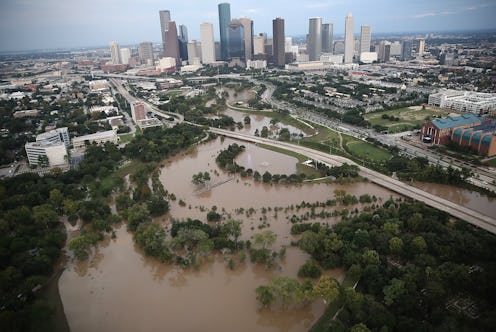
While residents in the southeastern United States continue to make sense of the chaos left behind after Hurricanes Harvey and Irma slammed Houston and Florida respectively, another major storm has approached the region. But as it begins to pummel Puerto Rico, one devastated state can breathe a little easier this week. Category 5 Hurricane Maria will not hit Texas, however, whether or not the monumental storm will hit the continental United States is still unclear.
Monday night, Hurricane Maria made its first landfall on Dominica, a Caribbean island nation. In a Facebook post, the country's prime minister, Roosevelt Skerrit, described the damage as "mind boggling," adding that he expected airports and seaports to "be inoperable for a few days."
Meteorologists predict that Hurricane Maria will follow Hurricane Jose's path, which is to say the storm will turn northeast before Florida, according to USA Today. It's too soon to say where Maria will head from there.
As for Puerto Rico, residents were instructed to "evacuate or die," according to NBC. President Donald Trump instituted a state of emergency for Puerto Rico and the U.S. Virgin Islands, both of which are U.S. territories. Puerto Rican reporter Norbert Figueroa told The Guardian that within three hours, "the number of displaced people increased ... from 500 to over 4,000 and counting." He urged anyone who is in the "danger" zone but outside of an official shelter to move to one immediately. A Puerto Rican resident named Anna Paez went on to tell The Guardian that the storm hit quickly, describing a calm drizzle preceding a sudden power outage.
A storm of this stature has not hit the island in nearly 100 years, making the storm of historic proportions before it even hits. According to CNN, 45,000 Puerto Rican homes were still without power because of damage wrought by Hurricane Irma last week.
As of 10 p.m. EST on Tuesday, Hurricane Maria was over the U.S. Virgin Islands, where 50,000 people are in the storm's direct path. The extent of the damage will be assessed as the storm leaves, but the devastation is anticipated to be extreme.
Meanwhile, in Houston, cleanup from Hurricane Harvey continues to unfold, with help pouring in from volunteers, nonprofits, and the government. The efforts, however, are expensive, and the question of where the funds for repair will come from has already been politicized. As it stands, state and city legislators are at odds over how the money should be raised. Currently, Houston Mayor Sylvester Turner has proposed a massive tax hike in order to cover the cost of repairs, The Houston Chronicle reported on Tuesday.
Specifically, Turner has suggested increasing property taxes from 58.64 cents per $100 to 63.87 cents, an increase his office says will raise $113 million that would be used toward damage relief. The Houston Chronicle reported that even with federal aid, the city was left scrambling to cover 10 percent of total repair costs. The proposition is already contentious, however, with Republican state senator Paul Bettencourt describing a property tax increase as "callous."
Several other Texas cities are considering tax hikes to pay for the devastation left in Harvey's wake. Total clean-up costs are estimated to run a price tag of about $57 million, according to CNBC. In turn, the total cost of damages incurred has been reported in the billions of dollars, with Bloomberg suggesting a net around $30 billion.
As of Tuesday, FEMA has approved over $428 million toward programs assisting "individuals and households" in Texas, with 232,282 individual assistance applications approved so far. The emergency aid agency offers assistance in a myriad of ways, but it cannot cover the relief efforts entirely on its own.
In the short term, Texas is expected to be spared another nightmarish storm. In the long term, however, the state will continue to grapple with how to deal with its increasingly mounting storm-relief debt.
Correction: An earlier version of this article misidentified a Guardian reporter. Bustle apologizes for this error.